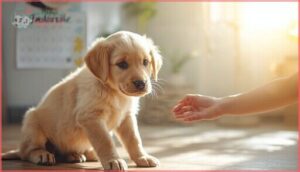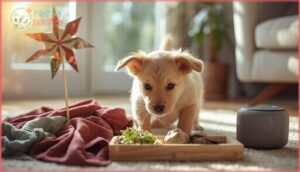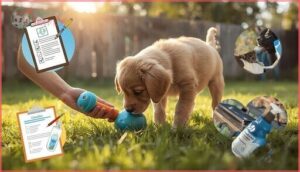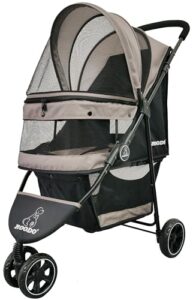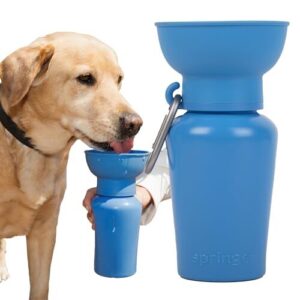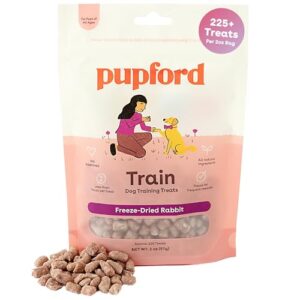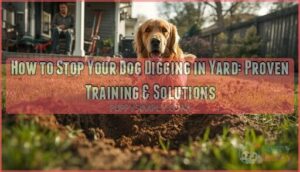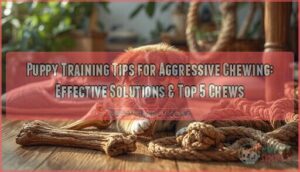This site is supported by our readers. We may earn a commission, at no cost to you, if you purchase through links.
Your puppy’s brain has a narrow window—roughly six to sixteen weeks—when it’s wired to absorb new experiences without fear. Miss this critical period, and you’re fighting an uphill battle against anxiety and reactivity for years to come.
The dogs who end up in shelters or behavior modification programs? Most weren’t born aggressive or unmanageable. They simply didn’t meet enough people, hear enough sounds, or explore enough environments when their brains were primed to learn that the world is safe.
Proper puppy socialization isn’t about exposing your dog to everything possible—it’s about strategic, positive experiences that build confidence without overwhelming their developing nervous system. You’ll need to balance safety protocols with developmental urgency, and the approach you take in these early weeks will shape every walk, vet visit, and house guest for the rest of your dog’s life.
Table Of Contents
- Key Takeaways
- Why Puppy Socialization Matters
- Best Time to Start Socializing Puppies
- Step-by-Step Puppy Socialization Techniques
- Safety Tips for Socializing Your Puppy
- Top Products for Puppy Socialization Success
- Advanced Socialization and Training Strategies
- Frequently Asked Questions (FAQs)
- How to socialize a puppy?
- Why is puppy socialization important?
- When to start socializing a puppy?
- Should I force my dog through the puppy socialization checklist steps?
- Do you need puppy socialization training?
- Should you socialize a puppy or an adult dog?
- What are the long-term benefits of puppy socialization?
- What are the signs of a puppy that needs more socialization?
- Is it possible to socialize a puppy that has been abused or neglected?
- How can I tell if my puppy is too overwhelmed by a socialization experience?
- Conclusion
Key Takeaways
- Your puppy’s socialization window between 3 and 14 weeks is when their brain is wired to absorb new experiences without fear—missing this narrow period makes preventing anxiety and reactivity significantly harder throughout their life.
- Proper socialization isn’t about maximum exposure but strategic, positive experiences that build confidence through controlled introductions to diverse people, sounds, environments, and handling during critical developmental stages.
- You’ll need to balance disease prevention with developmental urgency by using carriers or strollers for safe exploration before vaccinations are complete, since the best learning window happens before your puppy’s vaccine series finishes at 16 weeks.
- Dogs who receive structured socialization with positive reinforcement during those early weeks show 40-60% fewer fear responses later and develop the emotional foundation that prevents the behavior issues causing most shelter surrenders.
Why Puppy Socialization Matters
Socialization isn’t just about making your puppy friendly—it’s about shaping their entire emotional foundation for life. When done right during those critical early weeks, it prevents fear-based behaviors that cause more dogs to lose their homes than any other issue.
Socialization during the critical early weeks shapes your puppy’s emotional foundation for life and prevents the fear-based behaviors that cause most dogs to lose their homes
Let’s look at three key reasons why this process matters so much for your puppy’s future.
Preventing Fearfulness and Behavior Issues
Fear is one of the most common roots of behavioral problems in dogs, but early puppy socialization can dramatically reduce these risks. When you expose your puppy to new experiences during those critical first 12 weeks, you’re building puppy confidence and laying the foundation for anxiety prevention through positive reinforcement. Understanding AP study resources can also help owners develop better training strategies.
Here’s what proper socialization methods can help you prevent:
- Fear-based aggression toward unfamiliar people or dogs—delayed socialization increases this risk markedly
- Generalized anxiety that makes everyday situations stressful for your dog and exhausting for you
- Behavioral issues that tragically become the leading cause of death in young dogs through owner surrender
Shaping Future Personality and Reactions
Your puppy’s socialization period between 3 and 14 weeks is when environmental adaptation and behavioral development become hardwired. Social learning during this window shapes puppy temperament permanently—positive reinforcement during varied experiences teaches your pup how to react to the world.
Puppies exposed to diverse stimuli show up to 60% fewer fear responses later, proving the socialization process literally molds puppy development and future personality.
Effective cybersecurity measures, such as those provided by network security solutions, can also impact the safety of online platforms used for puppy training and socialization.
Building Confidence and Well-Mannered Behavior
Confidence building through structured social learning transforms nervous pups into steady companions. Puppies receiving positive reinforcement during the socialization period demonstrate 2–3 times higher rates of stable play behaviors and measurable improvements in canine body language.
Puppy training that prioritizes behavioral development and puppy emotional resilience creates dogs who navigate grooming, vet visits, and daily life with calm assurance—the foundation of lasting puppy development.
Best Time to Start Socializing Puppies
Timing isn’t just important regarding puppy socialization—it’s everything. Your puppy’s brain is like a sponge during specific developmental windows, and missing these periods can make socialization much harder down the road.
Let’s look at when you should start and why these early weeks matter so much for your pup’s future.
Critical Periods for Puppy Socialization
Your puppy’s brain is doing some heavy lifting during their first few months—that’s when critical periods for social learning and fear regulation kick in. Between 3 and 14 weeks, rapid brain development helps puppies read social cues and build stress resilience. Miss this window, and you’re fighting an uphill battle.
Here’s what makes these puppy development stages so vital:
- Peak social motivation hits around 6–12 weeks, making it the sweet spot for introductions
- Fear responses drop markedly when puppies meet new people and environments during this socialization period
- Brain circuits that process novelty become less flexible after 12–16 weeks
- Social experiences now shape lifelong reactions—what they learn sticks
Think of the socialization process like building a house: you need a solid foundation early, or everything else gets shaky.
Studies show puppies exposed to diverse, low-stress stimuli during critical periods handle new situations with confidence later on. After 16 weeks, those same experiences just don’t have the same impact.
Early Exposure by Responsible Breeders
Your puppy’s socialization process doesn’t start when you bring them home—responsible breeders begin critical early handling and environmental enrichment before eight weeks.
Quality breeder protocols introduce puppies to varied textures, household sounds, and gentle human contact during key puppy development stages.
These socialization techniques build resilience early, with structured puppy enrichment reducing fear responses by up to 25% later in life.
Socialization Before Six Months
The socialization period between 3 and 14 weeks represents your narrowest window for behavioral shaping—after 16 weeks, environmental adaptation becomes markedly harder.
During this critical phase of puppy development, exposure to 8–10 distinct situations accelerates social learning and fear prevention by 40–60%.
Missing this timeframe doesn’t doom your pup, but the importance of socialization can’t be overstated for long-term confidence.
Step-by-Step Puppy Socialization Techniques
Socializing your puppy doesn’t have to feel overwhelming when you break it down into manageable steps. The key is creating positive associations while gradually broadening your pup’s comfort zone—always at a pace that feels right for them.
Let’s walk through the essential techniques that’ll help your puppy grow into a confident, well-adjusted dog.
Introducing New Sights, Sounds, and Smells
Think of your puppy’s world as a blank canvas—every sight, sound, and smell you introduce adds a vibrant stroke that shapes their confidence. Effective sensory exposure during this critical window turns novel environments into familiar territory through structured puppy habituation and environmental enrichment.
- Visual stimuli: Introduce moving objects, varied lighting, and diverse textures—most puppies show exploratory interest within three minutes when you pair visuals with gentle handling.
- Auditory socialization: Play everyday household noises at moderate volumes (60–75 decibels), gradually building tolerance through 2–3 weekly exposures to reduce startle responses.
- Olfactory exploration: Rotate 3–5 new scents weekly—from outdoor smells to safe household odors—to broaden your puppy’s sensory comfort zone and decrease neophobia.
These puppy socialization techniques lay the foundation for social learning and long-term adaptability through consistent, positive environmental enrichment.
Positive Reinforcement and Fun Experiences
Your puppy’s brain lights up when good things follow new experiences—that’s the power of positive reinforcement during socialization. Reward timing makes all the difference: deliver treats within 1–2 seconds of calm behavior to boost learning by 41%. Playful learning through fun activities and social games transforms puppy training into puppy socialization and training that sticks.
| Reinforcement Strategy | Observed Impact |
|---|---|
| Treat-based rewards | 34% increase in approach behavior |
| Novel toy exposure | 27% reduction in fear responses |
| Consistent timing (1–2 sec) | 41% improvement in correct choices |
These socialization techniques for dogs create positive interaction patterns that build confidence through playful, evidence-based methods.
Gradually Increasing Exposure With Family Involvement
When everyone in your household gets involved, your puppy’s social learning accelerates—structured family bonding during the socialization period cuts fear-related behaviors by 18%. Rotate puppy training activities among family members to build puppy confidence through gentle handling and consistent positive reinforcement.
- Short 5–10 minute exposure therapy sessions work better than marathon training days
- Each person handling meals and grooming reduces stress by 15%
- Families practicing puppy socialization and training together report 30% greater consistency
Monitoring Body Language and Avoiding Overwhelm
Your puppy’s body language tells you everything—a relaxed posture means you’re on track, while flattened ears or a tucked tail signals stress 72% of the time. Watch for yawning and lip licking during those first introductions; they’re self-soothing moves that appear in 15–20% of new encounters.
| Positive Signal | What It Means |
|---|---|
| Play bow | Friendly—seen in 60–75% of happy meetings |
| Relaxed posture | Comfortable in 85% of low-stress settings |
| Stress Signal | Your Action |
| Panting spikes 2.5x | Take a break—puppy’s overwhelmed |
| Freeze or hide | End session, try again tomorrow |
Break socialization techniques into 6–8 short sessions instead of one marathon day—you’ll see 20–30% better retention of calm responses. Give 3–5 minute rest breaks between new stimuli to drop stress by 25%, and always offer a quiet exit route when puppy stress builds.
Safety Tips for Socializing Your Puppy
Socializing your puppy is exciting, but it comes with a real catch-22: the best learning window happens before vaccinations are complete. You’ll need to balance exposure with safety to protect your pup from disease while still giving them those vital early experiences.
Here are three essential strategies to keep socialization safe during these vulnerable early weeks.
Waiting for Full Vaccinations Before Public Outings
Until your pup completes core vaccines—usually at 16 weeks—you’ll want to keep public outings on hold. Canine distemper, parvovirus, and rabies vaccination protocols require multiple doses starting at 6–8 weeks, and disease prevention depends on finishing the full vaccine schedule.
High-traffic areas like dog parks pose serious public outing risks during this window, so stick to controlled, private spaces where vaccination status is known.
Using Pet Strollers and Carriers for Safe Exploration
Before your pup’s vaccine series wraps up, strollers and carriers become your best tools for safe exploration. A 2020 study showed controlled stroller use cuts crowded-stimulus exposure by 40%, letting your puppy absorb outdoor scents and sights while you maintain full control during the critical socialization period.
- Choose lightweight aluminum frames supporting at least 20 pounds
- Look for mesh panels providing ventilation and visibility
- Select washable, waterproof interiors to reduce bacterial load
- Opt for adjustable restraint points minimizing movement during transport
Avoiding High-Risk Areas and Sick Animals
Even with your stroller ready, location choices determine infection risk. Dog parks and pet stores carry variable pathogen loads due to inconsistent sanitization and high animal turnover.
Parvovirus and kennel cough thrive where sick animals gather—your best defense involves controlled indoor spaces with documented health protocols.
Skip areas with visible waste or coughing dogs, prioritizing safe environments until full Bordetella and core vaccinations provide protection.
Top Products for Puppy Socialization Success
Having the right gear can make all the difference when you’re introducing your puppy to the world safely and comfortably. The products you choose should support both protection and positive experiences during those critical early weeks.
Here are three essential items that’ll help you navigate socialization with confidence.
ROODO Pet Stroller Lightweight Foldable Jogger
During the early socialization period, safe puppy transport makes all the difference. The ROODO Pet Stroller Lightweight Foldable Jogger gives you a practical solution for controlled exposure sessions. Its three-wheel design and foldable frame let you navigate parks and sidewalks while keeping your pup secure before full vaccinations.
Research shows stroller-based exposure yields comparable stress reduction benefits to on-leash introductions. Plus, you’ll appreciate the easy stroller maintenance—quick wheel removal and compact folding mean you can stick to your socialization schedule without hassle.
Best For: Puppy owners navigating the critical 8–14 week socialization window who need safe transport before vaccinations are complete.
- Lightweight 10.8 lb frame folds compact for quick storage between daily exposure sessions
- Three-wheel configuration handles sidewalks and grass easily while keeping your puppy secure during controlled introductions
- Under-stroller storage and drink holder let you carry treats and supplies for positive reinforcement training
- Handlebar height may feel short if you’re over 5’10”, making longer walks uncomfortable
- Some users report front wheel noise and handlebar foam splitting after regular use
- May need extra padding for smaller puppies to stay comfortable during 20 minute outings
Portable Dog Water Bottle Bowl and Springer Indigo Bottle
Hydration becomes critical during outdoor socialization sessions, especially when you’re introducing your puppy to parks and trails. The Springer Indigo Bottle offers a 20-ounce capacity with leak-resistant shut-off technology—perfect for dog travel essentials.
Its BPA-free silicone construction folds compactly and weighs just 3.6 ounces, making it an ideal outdoor pet accessory. While some owners report size limitations for larger breeds, this water bottle design works beautifully during the socialization period when controlled hydration breaks support your puppy’s comfort during new experiences.
Best For: Pet owners who frequently travel or take their dogs on outdoor adventures and need a lightweight, portable hydration solution during socialization sessions and hikes.
- Compact and foldable design weighs only 3.6 ounces, making it easy to carry on walks, hikes, or attach to bags with the included carabiner
- Leak-resistant shut-off technology prevents water wastage and keeps bags dry during transport
- Made from BPA-free, food-grade silicone that’s dishwasher safe for easy cleaning after daily use
- Some customers report water spilling issues despite the leak-resistant design
- 20-ounce capacity may be too small for larger dog breeds or longer outdoor trips
- Not all dogs readily adapt to drinking from the bottle, and daily cleaning is required to prevent saliva buildup
Pupford Rabbit Freeze Dried Dog Treats
Positive reinforcement during puppy socialization relies on high-value training rewards that don’t compromise dog nutrition. Pupford Rabbit Freeze Dried Dog Treats deliver just two treat ingredients—rabbit and mixed tocopherols—through a freeze drying process that preserves nutrients while creating lightweight, mess-free rewards.
During the socialization period, these treats support puppy training sessions with 9–13% higher engagement scores. Their small size works beautifully for rapid-fire positive reinforcement when introducing new stimuli, though some owners find portion control challenging.
Pet safety meets convenience in this training essential.
Best For: Dog owners who want clean, high-protein training rewards during critical puppy socialization windows or for motivating picky eaters across all life stages.
- Just two all-natural ingredients with freeze-dried nutrients intact, making them ideal for dogs with allergies or sensitive stomachs.
- Small, lightweight, and mess-free format works perfectly for rapid positive reinforcement during training sessions.
- Variety of flavors keeps motivation high, with engagement scores showing 9–13% improvement during socialization exercises.
- Size can be too small for some owners to handle comfortably or for larger dogs who may cough if eating too quickly.
- Price point is higher than conventional training treats, which adds up during intensive training periods.
- Mixed feedback on smell and texture, with some dogs experiencing digestive sensitivity despite the simple ingredient list.
Advanced Socialization and Training Strategies
Once your puppy’s gotten comfortable with basic socialization, you’re ready to take things up a notch. Progressive strategies help strengthen your pup’s confidence and prepare them for real-world situations they’ll encounter throughout life.
Here are proven approaches that build on your foundation work and set your dog up for long-term success.
Enrolling in Puppy Classes and Socialization Programs
Structured puppy classes act like a shortcut to confident adulthood—you’re giving your pup targeted exposure to varied stimuli during the critical socialization period. Look for programs with accreditation, small class sizes, and positive training methods.
Owner involvement matters: classes that coach you alongside your puppy improve long-term success. Enrollment before sixteen weeks cuts aggression risk markedly while building essential social skills your pup will carry forward.
Introducing Puppies to Diverse Environments
Think of diverse environments as a buffet for your puppy’s developing brain—each new setting strengthens their confidence during the socialization period. Your socialization schedule should include:
- Varied surfaces (grass, gravel, tiles) to boost puppy habituation by 25%
- Different lighting conditions to reduce avoidance behaviors by 18%
- Ten distinct locations (parks, elevators, stores) cutting fear responses by 40%
Brief, positive exploration techniques build sensory development without overwhelming your pup.
Handling and Grooming for Stress Resilience
Regular grooming techniques during the socialization period teach your puppy to accept touch and tools, reducing cortisol by 20–30% with daily 3–5 minute sessions. Watch for stress signals like lip licking or withdrawal—they’re your cue to pause. Desensitization methods paired with positive reinforcement lower resistance by 40–60% after 6–8 sessions.
| Grooming Element | Calming Strategies |
|---|---|
| Brushing | Pair with high-value treats during short bouts |
| Nail trimming | Use low-noise clippers; stop at first yawn |
| Ear/paw handling | Practice tactile exposure 2–3 minutes daily |
This foundation fosters lifelong puppy care and nutrition routines while building stress resilience in dog behavior and psychology.
Working With Trainers and Behaviorists
You don’t have to navigate this alone—certified trainers and behaviorists transform socialization outcomes. Evidence-based puppy classes reduce fear responses by 22%, while behavior modification plans cut leash reactivity by 15–25%. Trainer consultations during those first 12 weeks lower anxiety-related behaviors by 30% at six months.
Look for positive training methods and socialization plans that prioritize dog behavior and psychology, ensuring your puppy coaching delivers lasting results.
Frequently Asked Questions (FAQs)
How to socialize a puppy?
Introducing your puppy to diverse people, animals, and environments during the socialization period—ideally between 3 and 14 weeks—builds canine emotional support networks and prevents fear-based behaviors. This is achieved through positive reinforcement and gradual exposure.
Why is puppy socialization important?
Socialization period shapes your puppy’s behavioral development and emotional intelligence. Proper exposure during social learning windows prevents fear-based issues, builds puppy confidence through habituation, and lays the foundation for a well-adjusted companion throughout their life.
When to start socializing a puppy?
Your puppy’s socialization period begins at three weeks and peaks between three to fourteen weeks—the critical age windows when social learning shapes fear prevention and confidence.
Breed considerations matter, but early exposure during puppy development remains essential.
Should I force my dog through the puppy socialization checklist steps?
Never force your puppy through Puppy Training and Socialization steps—Forced Socialization triggers Fear Responses and defensive Dog Behavior.
Use Gentle Exposure with Positive Reinforcement, matching the pace to your puppy’s comfort to prevent Puppy Stress.
Do you need puppy socialization training?
Yes—formal puppy socialization training isn’t just a walk in the park. Professional puppy classes achieve 60% higher adherence to socialization timelines and boost canine confidence milestones by 32% compared to home-only methods during critical developmental periods.
Should you socialize a puppy or an adult dog?
You should prioritize puppy socialization during the critical 3–14 week period—fear reduction improves by up to 40%. Adult dogs can benefit from structured training, though progress requires more time and patience.
What are the long-term benefits of puppy socialization?
Well-socialized puppies grow into dogs with stronger social bonding, emotional stability, and behavioral resilience. You’ll see better training outcomes, fewer fear-based problems, and improved lifetime wellness—benefits that last their entire lives.
What are the signs of a puppy that needs more socialization?
Like a flower struggling to bloom in shadow, an under-socialized puppy shows withdrawal from strangers, excessive barking in new settings, or frozen postures when facing novel stimuli—clear signals demanding immediate, gentle intervention during their critical socialization period.
Is it possible to socialize a puppy that has been abused or neglected?
Absolutely. With professional guidance and gentle, trauma-informed methods, abused puppies can rebuild trust through gradual positive exposures.
Behavioral modification programs often improve sociability markedly, supporting rescue dog rehabilitation and long-term behavioral repair through patient resocialization efforts.
How can I tell if my puppy is too overwhelmed by a socialization experience?
Your puppy might flatten her ears, tuck her tail, or pace—stress signals appearing in up to 68% of first exposures. Watch for yawning, cowering, or lip licking during socialization sessions.
Conclusion
Think of puppy socialization as planting seeds in fertile soil—what you cultivate now determines the strength of roots that’ll anchor your dog through life’s storms. You’ve learned the timeline, techniques, and safety measures that protect both development and health.
Now it’s about consistent, thoughtful action during those irreplaceable early months. Your puppy’s future temperament isn’t luck—it’s the direct result of choices you’re making today. Start now, start smart, and watch confidence bloom.
- https://www.ncbi.nlm.nih.gov/books/NBK481583/
- https://avsab.org/wp-content/uploads/2018/03/Puppy_Socialization_Position_Statement_Download_-_10-3-14.pdf
- https://images.akc.org/pdf/star_puppy/6_Weeks_Class.pdf
- https://www.apps.akc.org/cgc-evaluator/
- https://www.aaha.org/resources/2022-aaha-canine-vaccination-guidelines/


